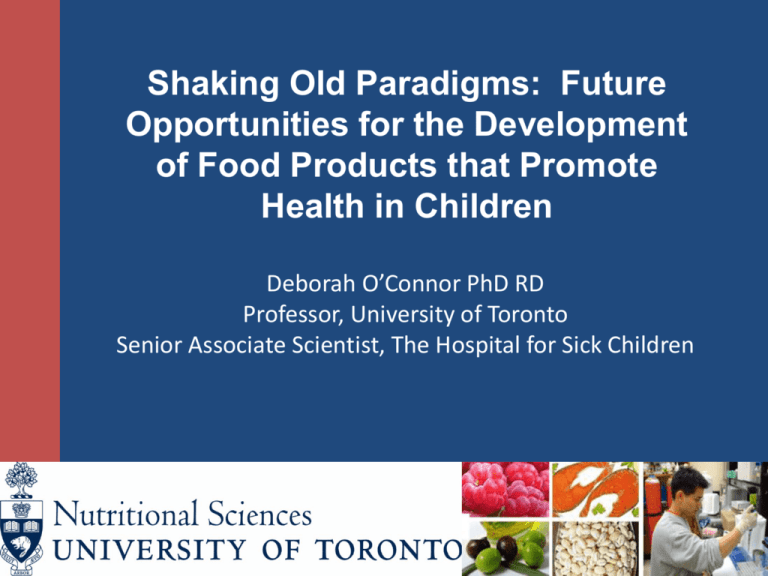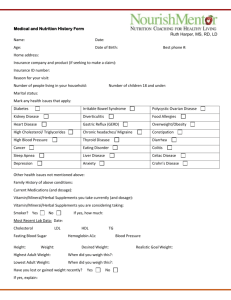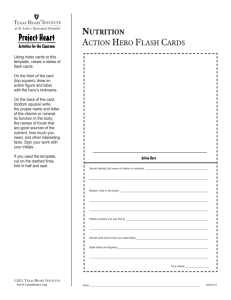Deborah O'Connor Children and Food
advertisement

Shaking Old Paradigms: Future Opportunities for the Development of Food Products that Promote Health in Children Deborah O’Connor PhD RD Professor, University of Toronto Senior Associate Scientist, The Hospital for Sick Children Considerations in Evaluating the Opportunities in Children 1. What are the most pressing health issues? 2. Can a new food product, or adaptation of an existing product, help address this issue? 3. Is it feasible to develop this product? 4. Translation of idea from bench to widespread use. What I Heard From the “Community”: Top 5 Calls 1. Weight Control: Programs, sample menus, “magic foods” 2. Picky Eaters: What can I put in this kid’s lunch? 3. Vitamin and Mineral Supplements 4. Management of Food Allergy and Food Sensitivities 5. Are “Organic” Foods Better? Weight Management in Children: Magnitude of the Problem in Canada Janssen I. Can J Diabetes 37:90-96, 2013 Eating Habits of Canadian Children and Youth Average Daily Calorie Consumption % of Kcal by Food Group Age (yrs) 1972 2004 2004 Avg Kcal Avg Kcal 95% CI 5-11 2,300 2,041 2,0052,076 Males: 12-19 3,251 2,806 2,7362,877 Females: 2,243 12-19 2,047 2,0022,092 Garriguet D. Health Reports 18(2):17-32, 2007. Eating Habits of Canadian Children and Youth % Below Recommended # Servings Vegetables and Fruit % Below Recommended # Servings Milk Products Garriguet D. Health Reports 18(2):17-32, 2007. Foods and Drinks Accounting for Most Calories from “Other Foods” (4 yrs +) Food/Drink % Kcal from “Other Foods” Soft drinks 11.3 Salad dressing 9.4 Sugars, syrups, preserves 8.7 Beer 8.2 Fruit drinks 6.1 Vegetable oil, animal fat, shortening 5.8 Margarine 5.3 Chocolate bars 4.8 Potato chips 4.7 Butter 3.9 Garriguet D. Health Reports 18(2):17-32, 2007. Snacks % of Kcal from Between Meal Consumption Age (yrs) % Kcal 4-8 27 Males: 9-13 26 % Distribution of Kcal from Between Meal Consumption, by Food Group (4 years +) Females: 26 9-13 Males: 14-18 30 Females: 28 14-18 Garriguet D. Health Reports 18(2):17-32, 2007. What I Heard From the “Community”: Top 5 Calls 1. Weight Control: Programs, sample menus, “magic foods” 2. Picky Eaters: What can I put in this kid’s lunch? 3. Vitamin and Mineral Supplements 4. Management of Food Allergy and Food Intolerance 5. Are “Organic” Foods Better? The Picky Eater 1. 25-35% of toddlers and preschoolers described as picky eaters. 2. Most grow appropriately but are at higher risk of being underweight. 3. Frequently cited as a cause of conflict in the family. 4. Canadian Pediatric Association states no role for specialty formulas. Suggests a vitamin or mineral supplements if diet is questionable. 5. CPS and others recommend small portions be provided and meals and snacks be of high nutrient density. No juice at snack-time. 6. Lunches a source of much parental concern—in a recent Canadian study home lunches were of lower quality than those purchased at school. Leung AKC et al. Paediatr Child Health 17(8): 455-457, 2012; Dubois L et al. International J Behavioral Nutrition Physical Activity 4:9, 2007; Taylor JP eta al Public Health Nutr 15(12):2259-2264, 2012. What I Heard From the “Community”: Top 5 Calls 1. Weight Control: Programs, sample menus, “magic foods” 2. Picky Eaters: What can I put in this kid’s lunch? 3. Vitamin and Mineral Supplements 4. Management of Food Allergy and Food Sensitivities 5. Are “Organic” Foods Better? Vitamins and/or Minerals Supplements Group Any Vitamin or Mineral Multivitamin/ Mineral Vitamin A Vitamin C Vitamin D 1-3 38 35 35 36 35 4-8 45 42 41 44 41 9-13 33 25 24 31 24 Males 23 15 14 21 15 Females 29 17 16 24 17 Children Adolescents 14-18 Shakur YA et al. J Nutr 142(3):534-540, 2012 Minerals Supplements Group Multivitamin/ Mineral Calcium Phosphorus Magnesium Iron Zinc Children 1-3 38 21 16 2 20 2 4-8 45 28 21 3 24 2 9-13 33 16 12 4 15 3 Males 23 14 10 9 11 8 Females 29 15 8 11 14 9 Adolescents 14-18 Shakur YA et al. J Nutr 142(3):534-540, 2012 Prevalence of Nutrient Inadequacy Children 1-13 years • Use of supplements reduced prevalence of inadequacy of vitamin D (1-3), calcium (4-13 years). Youth 14-18 • Use of supplements reduced prevalence of inadequacy of vitamin D and calcium (females only). Shakur YA et al. J Nutr 142(3):534-540, 2012 What I Heard From the “Community”: Top 5 Calls 1. Weight Control: Programs, sample menus, “magic foods” 2. Picky Eaters: What can I put in this kid’s lunch? 3. Vitamin and Mineral Supplements 4. Management of Food Allergy and Food Sensitivities 5. Are “Organic” Foods Better? Management of Food Allergy and Other Food Sensitivities 1. Allergy most common in infants and young children (6-8% in children <3 years of age) 2. Frequently associated with atopic dermatitis, asthma 3. Most common allergies are to: milk, egg and nuts 4. Non-celiac Gluten Sensitivity Management of Food Allergy and Other Food Sensitivities Where Novel Food Products Could Help Families 1. Nutrient Dense Food in snack-sized portions—low kcal, low sodium, no trans fat. 2. Foods that address the milk product and vegetable and fruit gap—excellent sources of fibre. 3. Targeted supplementation—multivitamin supplements don’t make a lot of sense for most healthy children. 4. Movement away from beverages (formulas, energydrinks), sugary products targeted for children and movement toward “whole foods” that are convenient for parents and kids want to eat. 5. Availability of food products for those with food allergies and other food sensitivities—clearly labeled. Food Products Designed for Feeding Sick and Vulnerable Infants Children and Youth 1. Number of children that could potentially use a product fewer than number of adult patients who could benefit from a comparable product. 2. However, …the impact of the product on health is tremendous…often life-saving. – – – – Metabolic formulas (available) Engineering human milk for clinical indications (work in progress) Probiotics (work in progress) Novel lipid-based approaches for the treatment of intestinalfailure associated liver disease 3. Issues of “powders” in the hospital environment. An Exclusive Human Milk Diet for Very Low Birth Weight Infants Necrotizing Enterocolitis Symptoms may include: poor feeding tolerance delayed gastric emptying abdominal distension emesis bloody stools Advanced cases may show fluid in the peritoneal cavity, peritonitis, or shock. Is There An Advantage of an Exclusive Human Milk Diet for NEC Prevention? • Infants fed mothers’ own milk randomized to: 1. HM100 2. HM40 3. BOV Pasteurized donor milk + “human” milk fortifier Preterm formula + “bovine” milk fortifier *Sullivan et al Journal of Pediatrics 2010;156:562-7. Is There An Advantage of an Exclusive Human Milk Diet for NEC Prevention? • Mothers’ own milk comprised ~ 70% of feedings • > 50% in NEC • Reduction in surgical NEC *Sullivan et al Journal of Pediatrics 2010;156:562-7. Probiotics Probiotics for the Prevention of NEC: Mortality Outcome *AlFaleh K et al. Evid.-Based Child Health 7:6:1807-1854, 2012 Novel Lipid-Based Approaches to Pediatric Intestinal FailureAssociated Liver Disease Novel Lipid-Based Approaches to Pediatric Intestinal Failure-Associated Liver Disease (IFALD) Fatty Acid Intralipid Omegaven %fatty acids Palmitic 10 2.5-10 Stearic 3.5 0.5-2.0 Oleic 26 6-13 Linoleic 50 1-7 a-linolenic 9 <2 ARA 0 1-4 EPA 0 12.8-28.2 DHA 0 14.4-30.9 N-6/n-3 5.5/1 1/6.8 Clinical Experience with Novel Therapies in Children with IFALD • Dramatic reductions in the number of children: – With hyperbilirubinemia – Requiring transplant – Significant reduction of morbidity *Diamond IR et al. Arch Pediatr Adolesc Med 166(5):473-478, 2012 Conclusions 1. Many health issues with children that could be impacted by availability of new and adapted food products. 2. In terms of which products to develop for children when? - Need to consider size of target population Potential magnitude of the effect on health outcome Feasibility in terms of product development, cost etc Strategy to Promote Longer-term Health Needs Goes Beyond Patching up a Poor Diet Vitamin C folate calcium vitamin A iron Omega-3 fatty acid







